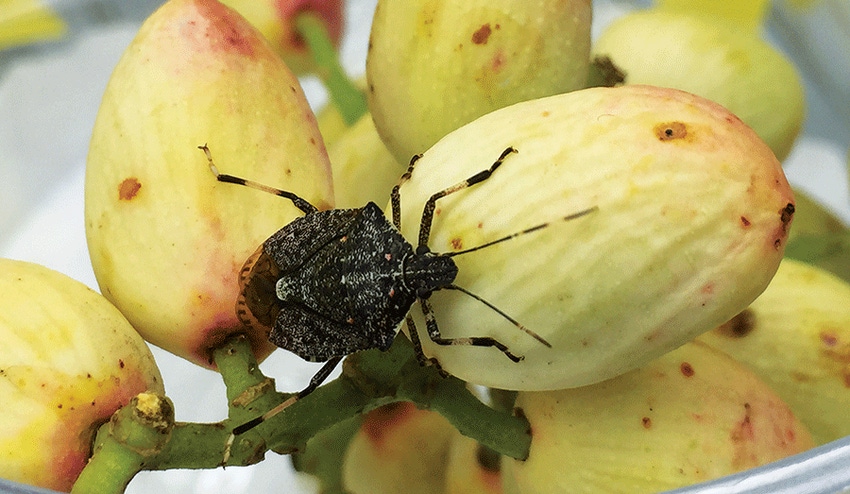
Time will tell if California’s San Joaquin Valley climate is too hot and dry for the brown marmorated stink bug (BMSB) to become established and threaten the scores of specialty crops produced there.
This invasive pest has been found in Fresno County, but not in a commercial setting. Ricky Lara, University of California Riverside researcher, says Fresno and four more counties were added by California Department of Food and Agriculture to the list of places where BMSB had been found during 2017.
Besides Fresno, the pest was found in Glenn, Napa, Nevada, and Orange counties. In total, it has been recorded in 34 California counties. In 2016, monitoring traps deployed in Stanislaus County by Jhalendra Rijal, University of California area IPM advisor, caught BMSB in a peach orchard.
Lara, along with Mark Hoddle, UC Extension specialist in entomology, is investigating the potential of the pest to affect commercial fruit and nut crops. The UCR research is part of a nationwide USDA Specialty Crop Research Initiative-funded program to monitor and control BMSB. Funding from CDFA’s Specialty Block Grant Program has also been crucial in advancing BMSB management research for the benefit of California stakeholders.
POTENTIAL PISTACHIO PROBLEM
Hoddle reports that BMSB can feed on pistachio crops and cause kernel necrosis. In addition to the potential for economic crop damage, Lara says, BMSB poses other challenges. It is a very strong flyer, and chemical control efforts alone could disrupt established integrated pest management strategies in production agriculture.
There are pesticides registered for stink bug control in pistachio and almond crops, but Lara says that due to the behavioral characteristics of the pest, they might not be entirely effective for control. Therefore, other avenues for control, such as the directed use of BMSB-specific natural enemies from China, are being explored.
BMSB is a native of Asia and arrived in the U.S. in the 1990s, where it caused damage to crops on the east coast. Lara says missing information on BMSB is its tolerance to hot temperatures in California. Climate data from parts of Asia where BMSB is thriving could give researchers more knowledge about the potential for its spread in California.
FIELD TESTS PLANNED
Field tests will be conducted this year, Lara says, exposing crops to BMSB feeding in order to determine the potential for economic damage. In some southern California counties where BMSB has been found, he says, it has been trapped on residential citrus, but it remains to be shown if commercial citrus is at risk.
There are two key natural enemies of stink bugs that have been evaluated for use as biological controls: resident predators and parasitoids that attack eggs of native stink bugs, and a wasp native to Asia that parasitizes BMSB eggs. The wasp, Trissolcus japonicus, better known as ‘samurai wasp,’ has been found in Oregon and Washington where BMSB have been found. Lara says part of this year’s research will be to place sentinel egg cards where BMSB has been found to see if the wasp is also in California.
DISTINGUISHING CHARACTERISTICS
Adult BMSB has a typical stink bug shape, but it can be distinguished from native stink bugs of comparable color by the presence of white bands on antennae and legs, rounded shoulders, and a prominent light-dark banding pattern on the abdomen.
Eggs are barrel-shaped, white to pale green in color, and are laid as egg masses on leaves. Newly hatched nymphs resemble those of other resident stink bugs, so identification is much easier in adults.
Reproducing populations of BMSB will aggregate in the fall and move to protected places, including human-made structures, to overwinter. Adults become active in the spring when they feed. After mating the female lays eggs in clusters on plant material. There is at least one generation per year in California, but in warmer areas, two could be expected. UC Farm Advisor Chuck Ingels has detected at least two generations in Sacramento County.
Lara says a trapping strategy is being used in Fresno County to monitor the spread of BMSB populations. The find there by local UC researchers was in close proximity to State Route 41.
About the Author(s)
You May Also Like




